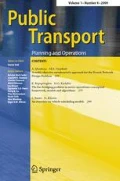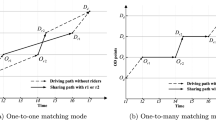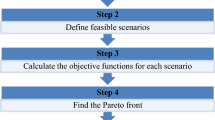Abstract
Subscription bus services (SBS) is a convenient and low-carbon rapid transport mode for passengers’ daily commute. The network design becomes a vital problem because it closely relates to both operators’ profit and passengers’ daily convenient traveling. In this paper, a two-stage model is formulated to optimize the subscription bus services network design (SBSND). During the first stage we minimize the total service distance and the number of vehicles as a single target objective function; vehicle capacity utilization rate, service time, ratio of service distance and linear distance between origin and destination are limited by means of constraints. During the second stage we share the same objective function and similar constraints used during the first stage, but the parameter settings of the constraints are different. Correspondingly, a two-stage algorithm is also designed to solve the SBSND problem. Firstly, we obtain the possible service lines, match the passengers and bus capacity. Next, we use Dijkstra to obtain the shortest SBS operation lines. Finally, we form the SBS network. The three phases are the main processes about the algorithm during both stages. The comparison between existing SBS in Chengdu city and the optimized SBS shows the high efficiency of the optimization model and algorithm formulated in this paper: the operation line length increases from 250.6 to 300.9 km; only 40 passengers have no SBS after optimization; the average operation time is reduced from 56.8 to 50.2 min.




Similar content being viewed by others
References
Agrawal J, Mathew TV (2004) Transit route network design using parallel genetic algorithm. J Comput Civil Eng 18:248–256
Amiripour S, Ceder A, Mohaymany A (2014) Designing large-scale bus network with seasonal variations of demand. Transp Res Part C Emerg Tech 48:322–338
An J, Yao GZ, Sun L, Zhang D (2015) A study of willingness-to-pay on subscription bus services in Beijing. Urban Transp China 02:63–71
Baaj M, Mahmassani H (1991) An AI-based approach for transit route system planning and design. J Adv Transp 25:187–209
Baaj M, Mahmassani H (1992) AI-based system representation and search procedures for transit route network design. Transp Res Rec J Transp Res Board 1358:67–70
Baaj M, Mahmassani H (1995) A hybrid route generation heuristic algorithm for the design of transit networks. Transp Res Part C Emerg Tech 3:31–50
Bagloee S, Ceder A (2011) Transit-network design methodology for actual-size road networks. Transp Res Part B Methodol 45:1787–1804
Boriboonsomsin K, Barth M (2008) Impacts of freeway high-occupancy vehicle lane configuration on vehicle emissions. Transp Res Part D Transport Environ 13(2):112–125
Brown AL, Affum JK (2002) A GIS-based environmental modeling system for transportation planners. Comput Environ Urban Syst 26(6):577–590
Chakroborty P (2003) Genetic algorithms for optimal urban transit network design. Comput Aided Civil Infrastruct Eng 18:184–200
Chang SK, Schonfeld PM (1989) Optimization models for comparing conventional and subscription bus feeder services. Transp Sci 25(4):281–298
Chang S, Yu WJ (1996) Comparison of subsidized fixed-and flexible-route bus systems. Transp Res Rec J Transport Res Board 1557:15–20
Chen A, Yang C (2004) Stochastic transportation network design problem with spatial equity constraint. Transp Res Rec J Transp Res Board 1882:97–104
Cheng LQ (2014) Study on the line network layout of customized shuttle bus planning of the level analysis method of point, line and plane. J Dalian Jiaotong Univ 03:23–26
Chew JSC, Lee LS, Seow HV (2013) Genetic algorithm for biobjective urban transit routing problem. J Appl Math 2013:698645
Chien S, Spasovic L, Elefsiniotis S, Chhonkar R (2001) Evaluation of feeder bus systems with probabilistic time-varying demands and non-additive time costs. Transp Res Rec J Transp Res Board 1760:47–55
Cipriani E, Gori S, Petrelli M (2012) A bus network design procedure with elastic demand for large urban areas. Public Transp 4:57–76
Fan W, Machemehl RB (2008) A tabu search based heuristic method for the transit route network design problem. In: Hickman M, Mirchandani P, Voß S (eds) Computer-aided systems in public transport. Lecture notes in economics and mathematical systems, vol 600. Springer, Berlin, pp 387–408
Fan YL, Guthrie A, Levinson D (2016) Waiting time perceptions at transit stops and stations: effects of basic amenities, gender, and security. Transp Res Part A Policy Pract 88:251–264
Fernández JE, de Cea Ch. J, Malbran RH (2008) Demand responsive urban public transport system design: methodology and application. Transp Res Part A Policy Pract 42:951–972
Fonzone A, Schmöcker JD, Liu R (2015) A model of bus bunching under reliability-based passenger arrival patterns. Transp Res Part C Emerg Tech 7:164–182
Gao Z, Sun H, Shan L (2004) A continuous equilibrium network design model and algorithm for transit systems. Transp Res Part B Methodol 38:235–250
Gardner LM, Bar-Gera H, Boyles SD (2013) Development and comparison of choice models and tolling schemes for high-occupancy/toll (HOT) facilities. Transp Res Part B Methodol 55(9):142–153
Jang K, Chung K, Yeo H (2014) A dynamic pricing strategy for high occupancy toll lanes. Transp Res Part A Policy Pract 67:69–80
Jerby S, Ceder A (2006) Optimal routing design for shuttle bus service. Transp Res Rec J Transp Res Board 1971(1):14–22
Jiang YS, Hu L, Zhu JX, Chen YR (2013) PH fitting of the arrival interval distribution of the passenger flow on urban rail transit stations. Appl Math Comput 225(12):158–170
Kirby RF, Bhatt KU (1975a) An analysis of subscription bus experience. Traffic Q 29(3):403–425
Kirby RF, Bhatt KU (1975b) Guidelines on the operation of subscription bus services. Urban Institute Press, Washington
Lou Y, Yin Y, Laval JA (2011) Optimal dynamic pricing strategies for high-occupancy/toll lanes. Transp Res Part C Emerg Tech 19(1):64–74
Marković N, Nair R, Schonfeld P, Miller-Hooks E, Mohebbi M (2015) Optimizing dial-a-ride services in Maryland: benefits of computerized routing and scheduling. Transp Res Part C Emerg Tech 55:156–165
Marković N, Kim M, Schonfeld P (2016) Statistical and machine learning approach for planning dial-a-ride systems. Transp Res Part A Policy Pract 89:41–55
Marwah B, Umrigar F, Patnaik S (1984) Optimal design of bus routes and frequencies for Ahmedabad. Transp Res Rec J Transp Res Board 994:41–47
Mauttone A, Urquhart M (2009) A multi-objective metaheuristic approach for the transit network design problem. Public Transp 1:253–273
McCall CHJ (1977) Com-Bus: a Southern California subscription bus service. Report DOT-TSC-UMTA-77-13, U.S. Department of Transportation, Washington, DC
Nayeem M, Rahman MK, Rahman MS (2014) Transit network design by genetic algorithm with elitism. Transp Res Part C Emerg Tech 46:30–45
Nikolić M, Teodorović D (2013) Transit network design by bee colony optimization. Expert Syst Appl 40:5945–5955
Nikolić M, Teodorović D (2014) A simultaneous transit network design and frequency setting: computing with bees. Expert Syst Appl 41:7200–7209
Richard HP, Garrett P (2000) Traveler response to transportation system changes interim handbook, chap 6. In: Demand responsive ADA. Transit cooperative research program, March 2000
Sayarshad HR, Chow JYJ (2015) A scalable non-myopic dynamic dial-a-ride and pricing problem. Transp Res Part B Methodol 81:539–554
Szeto W, Jiang Y (2012) Hybrid artificial bee colony algorithm for transit network design. Transp Res Rec J Transp Res Board 2284:47–56
Szeto W, Jiang Y (2014) Transit route and frequency design: bi-level modeling and hybrid artificial bee colony algorithm approach. Transp Res Part B Methodol 67:235–263
Szeto W, Wu Y (2011) A simultaneous bus route designing and frequency setting problem for Tin Shui Wai, Hong Kong. Eur J Oper Res 209:141–155
van Nes R, Hamerslag R, Immers B (1988) Design of public transport networks. Transp Res Rec J Transp Res Board 1202:74–83
Varaiya P, Han HM (2008) Effectiveness of California’s high occupancy vehicle (HOV) system. Transp Res Part C Emerg Tech 16(1):98–115
Xu KM, Li J, Feng J, Yun Z (2013) Discussion on subscription bus services. Urban Transp China 5:24–27
Yan Y, Liu Z, Meng Q, Jiang Y (2013) Robust optimization model of bus transit network design with stochastic travel time. J Transp Eng 139:625–634
Yu B, Yang ZZ, Jin PH, Wu SH, Yao BZ (2012) Transit route network design-maximizing direct and transfer demand density. Transp Res Part C Emerg Tech 22:58–75
Zhang MJ, Feng S, Lv CX, Guo L (2014) Custom bus routes optimization model and its algorithm. In: The ninth China intelligent transport annual meeting of the general assembly proceedings, vol 8, pp 15–27
Acknowledgements
This research was jointly supported by the Traffic and Transportation Engineering Experiment and Comprehensive Innovation Center, School of Transportation and Logistics, Southwest Jiaotong University, Chengdu Sichuan. Subsidized by National Natural Science Foundation of China (71173177). China State Railway Administration of Science and Technology Legal Division (KF2013-020), Southwest Jiaotong University 2015 Graduate Innovative Experimental and Practice Program (YC201507103), and Southwest Jiaotong University 2018 Postgraduate Academic Literacy Improvement Plan (2018KXK04). Also the authors would like to thank the anonymous referees for their valuable comments and suggestions.
Author information
Authors and Affiliations
Corresponding author
Rights and permissions
About this article
Cite this article
Huang, W., Shuai, B. & Antwi, E. A two-stage optimization approach for subscription bus services network design: the China case. Public Transp 11, 589–616 (2019). https://doi.org/10.1007/s12469-018-0182-6
Accepted:
Published:
Issue Date:
DOI: https://doi.org/10.1007/s12469-018-0182-6




